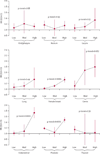Proportion of second cancers attributable to radiotherapy treatment in adults: a cohort study in the US SEER cancer registries
- PMID: 21454129
- PMCID: PMC3086738
- DOI: 10.1016/S1470-2045(11)70061-4
Proportion of second cancers attributable to radiotherapy treatment in adults: a cohort study in the US SEER cancer registries
Abstract
Background: Improvements in cancer survival have made the long-term risks from treatments more important, including the risk of developing a second cancer after radiotherapy. We aimed to estimate the proportion of second cancers attributable to radiotherapy in adults with data from the US Surveillance, Epidemiology and End Results (SEER) cancer registries.
Methods: We used nine of the SEER registries to systematically analyse 15 cancer sites that are routinely treated with radiotherapy (oral and pharynx, salivary gland, rectum, anus, larynx, lung, soft tissue, female breast, cervix, endometrial, prostate, testes, eye and orbit, brain and CNS, and thyroid). The cohort we studied was composed of patients aged 20 years or older who were diagnosed with a first primary invasive solid cancer reported in the SEER registries between Jan 1, 1973, and Dec 31, 2002. Relative risks (RRs) for second cancer in patients treated with radiotherapy versus patients not treated with radiotherapy were estimated with Poisson regression adjusted for age, stage, and other potential confounders.
Findings: 647,672 cancer patients who were 5-year survivors were followed up for a mean 12 years (SD 4.5, range 5-34); 60,271 (9%) developed a second solid cancer. For each of the first cancer sites the RR of developing a second cancer associated with radiotherapy exceeded 1, and varied from 1.08 (95% CI 0.79-1.46) after cancers of the eye and orbit to 1.43 (1.13-1.84) after cancer of the testes. In general, the RR was highest for organs that typically received greater than 5 Gy, decreased with increasing age at diagnosis, and increased with time since diagnosis. We estimated a total of 3266 (2862-3670) excess second solid cancers that could be related to radiotherapy, that is 8% (7-9) of the total in all radiotherapy patients (≥1 year survivors) and five excess cancers per 1000 patients treated with radiotherapy by 15 years after diagnosis.
Interpretation: A relatively small proportion of second cancers are related to radiotherapy in adults, suggesting that most are due to other factors, such as lifestyle or genetics.
Funding: US National Cancer Institute.
Copyright © 2011 Elsevier Ltd. All rights reserved.
Conflict of interest statement
Conflicts of Interest Statements: The authors declared no conflicts of interest.
Figures


References
-
- Lawrence TS, Ten Haken RK, Giaccia A. Principles of Radiation Oncology. In: DeVita VT Jr, Lawrence TS, Rosenberg SA, editors. Cancer: Principles and Practice of Oncology. 8th ed. Philadelphia: Lippincott Williams and Wilkins; 2008.
-
- Surveillance Research Program. National Cancer Institute SEER*Stat software ( www.seer.cancer.gov/seerstat) version 6.4.4
-
- Fraumeni J, et al. In: Introduction to “New malignancies among cancer survivors: SEER cancer registries, 1973–2000.”. Curtis RL, et al., editors. Bethesda MD: National Cancer Institute NIH Publ No 05-5302; 2006.
Publication types
MeSH terms
Grants and funding
LinkOut - more resources
Full Text Sources
Medical
Research Materials

